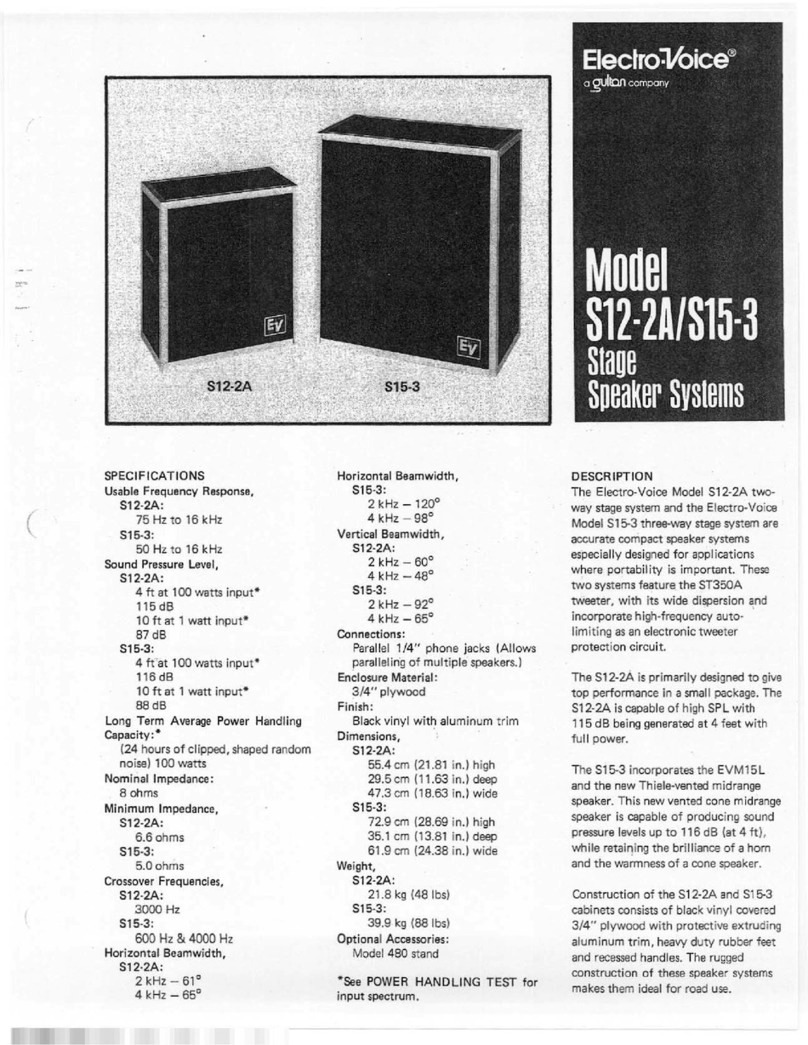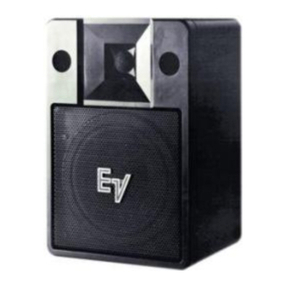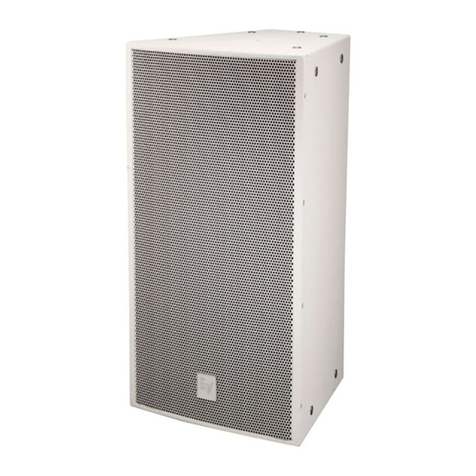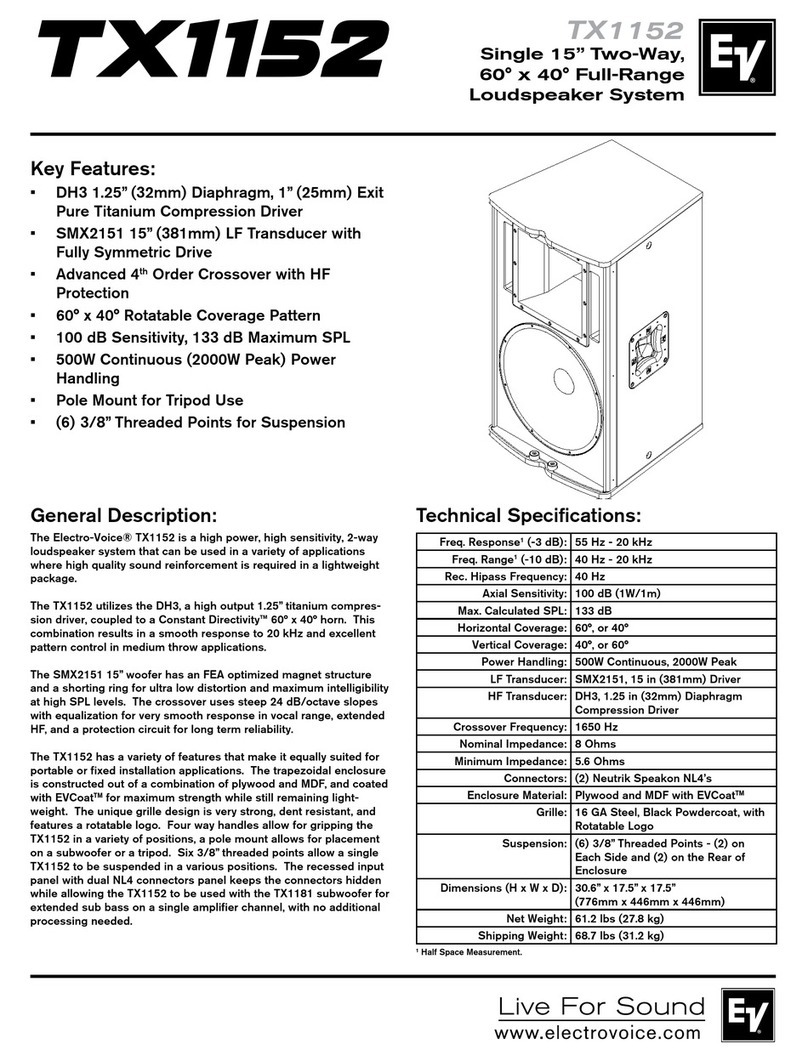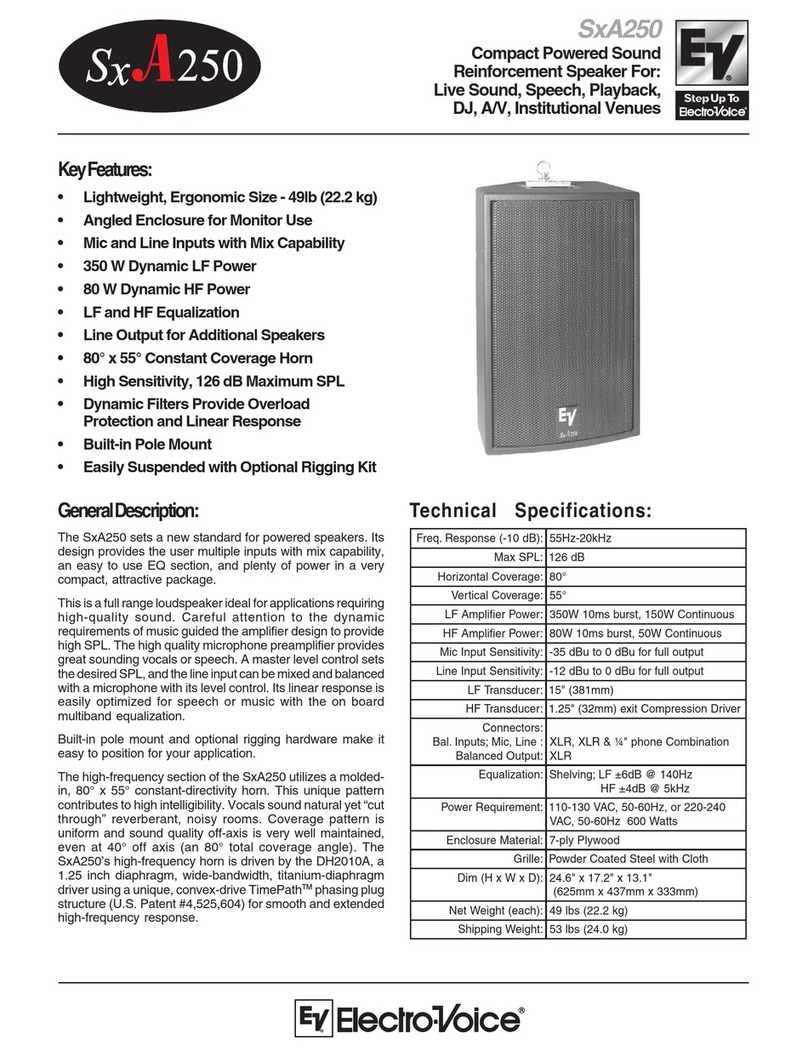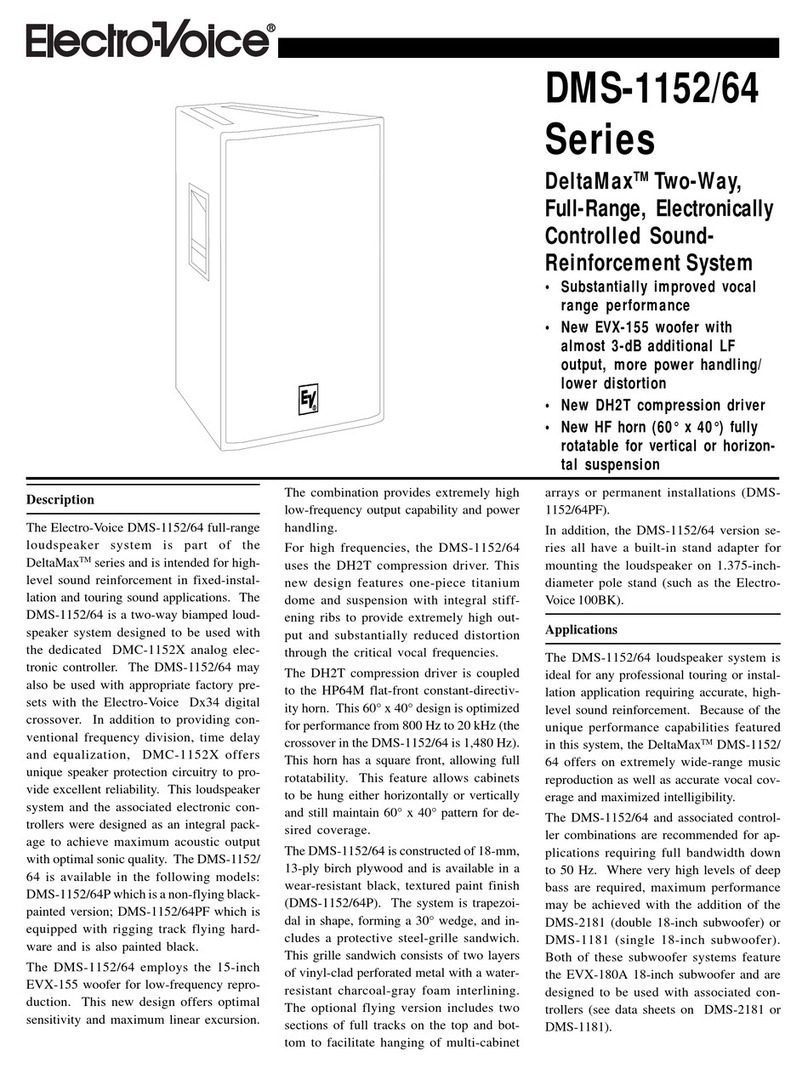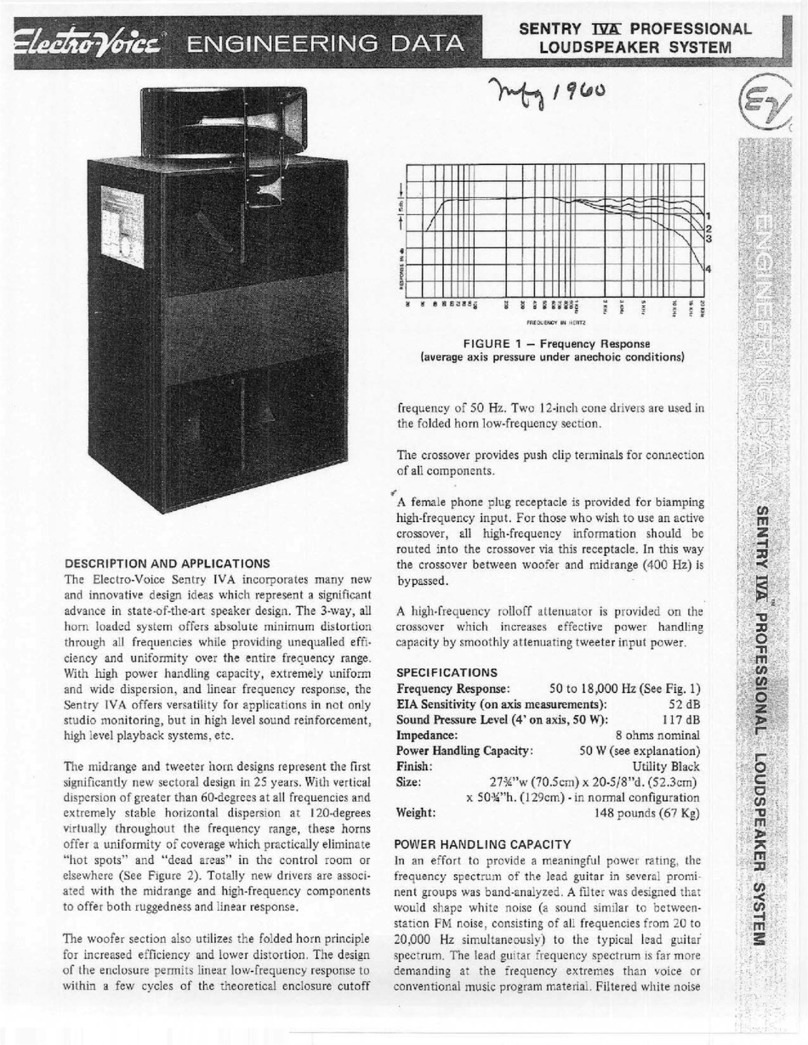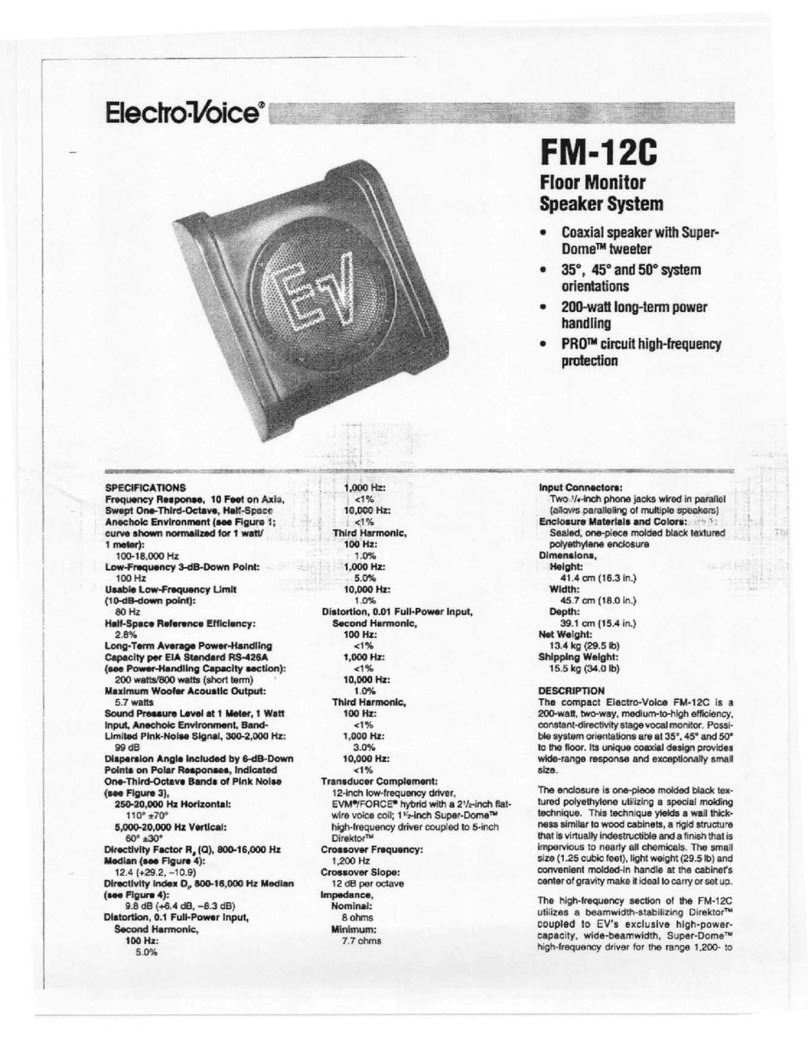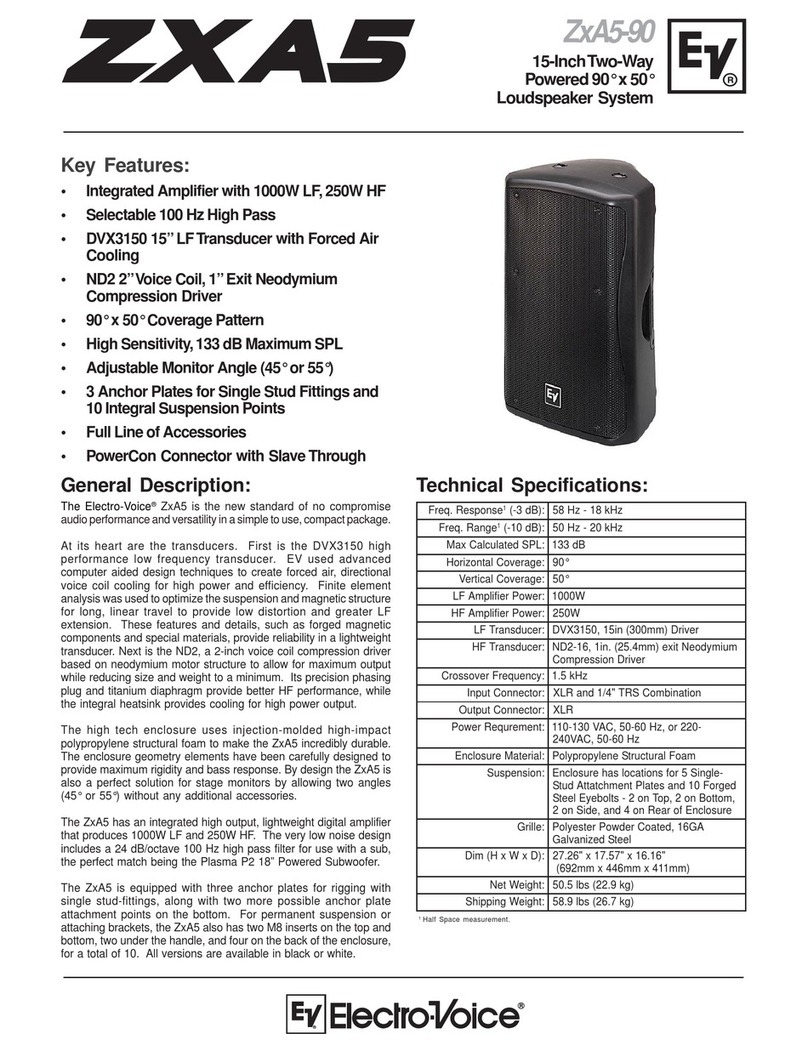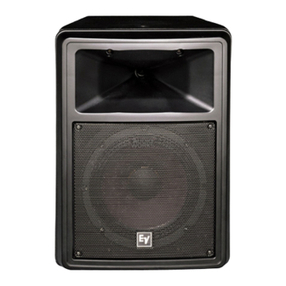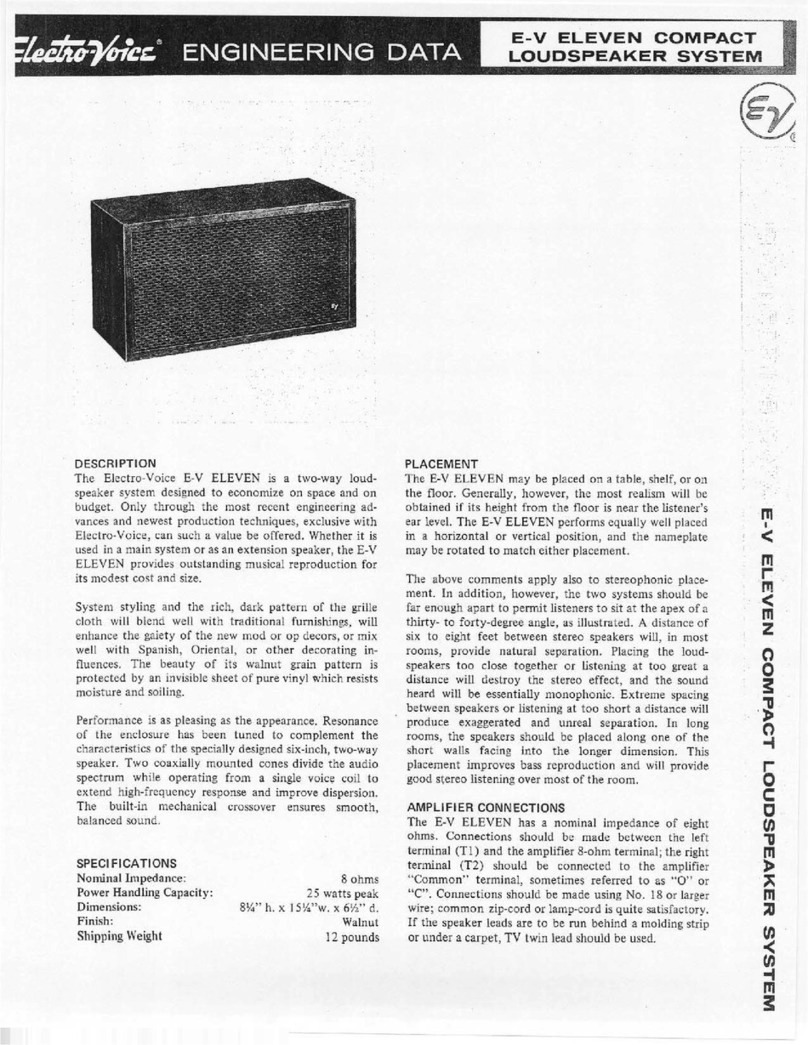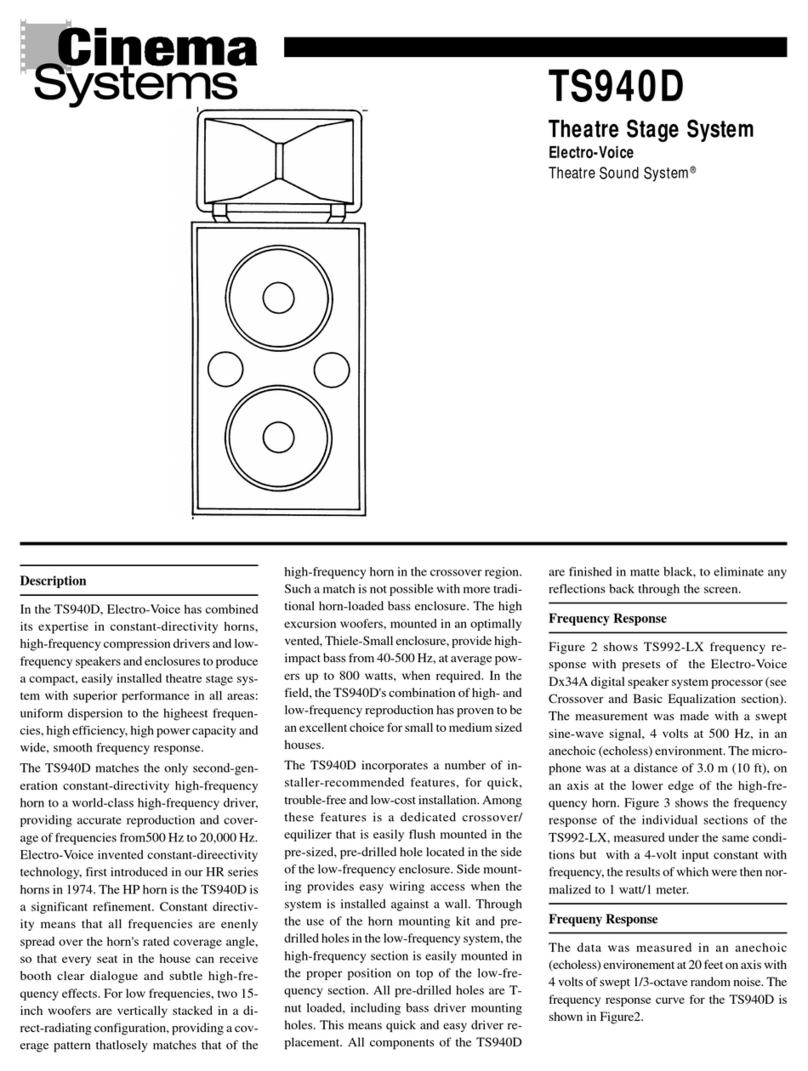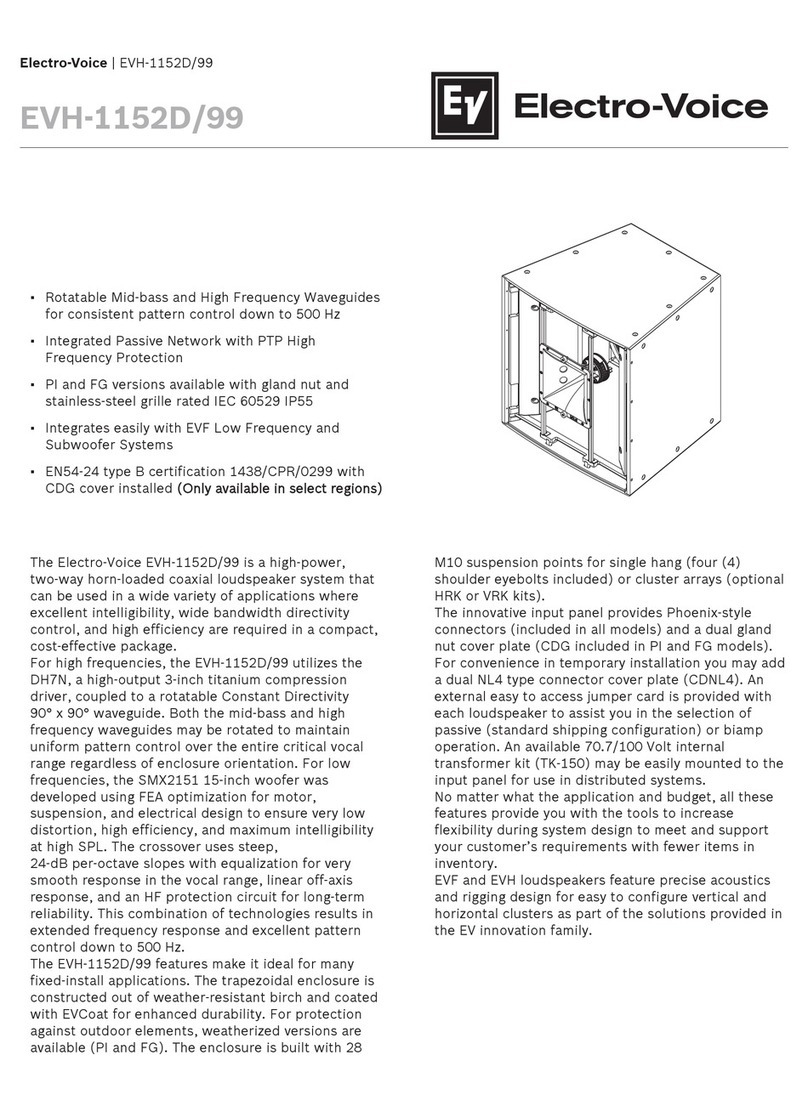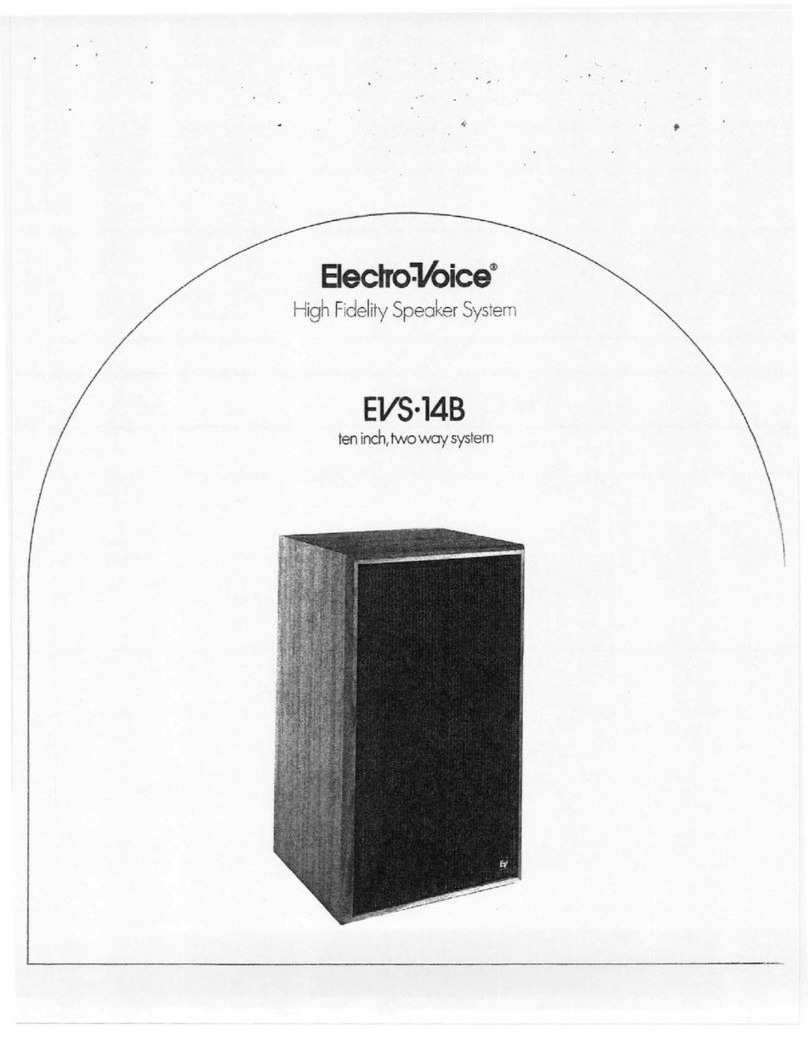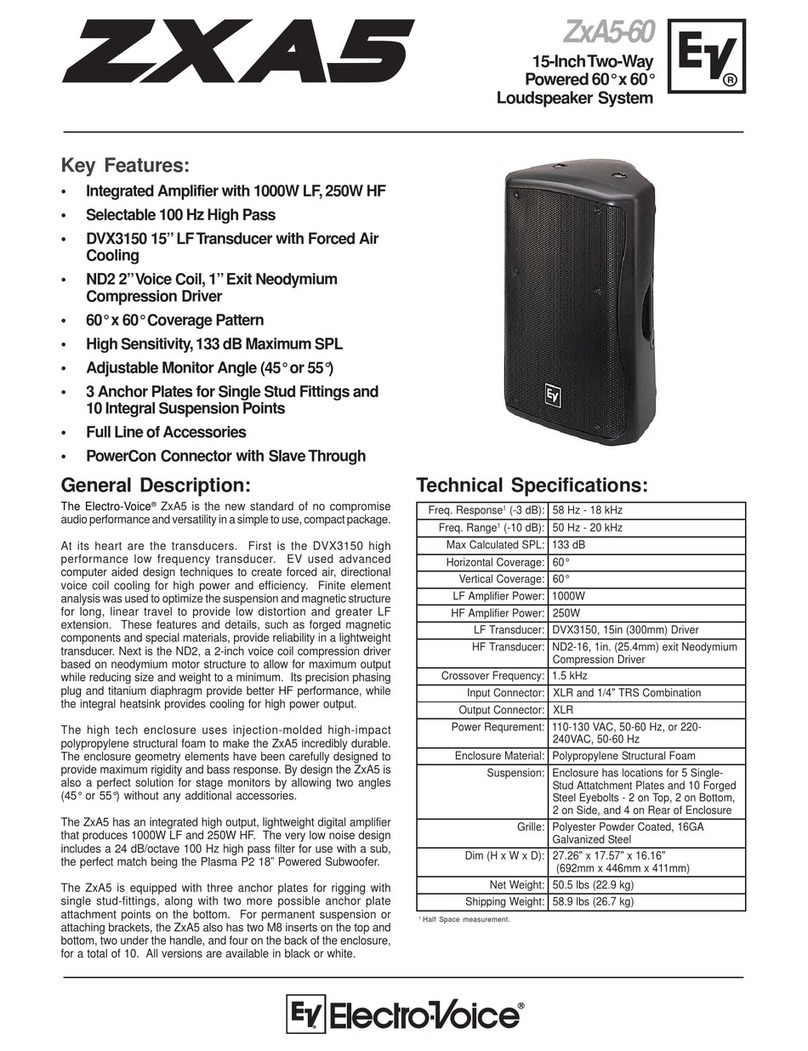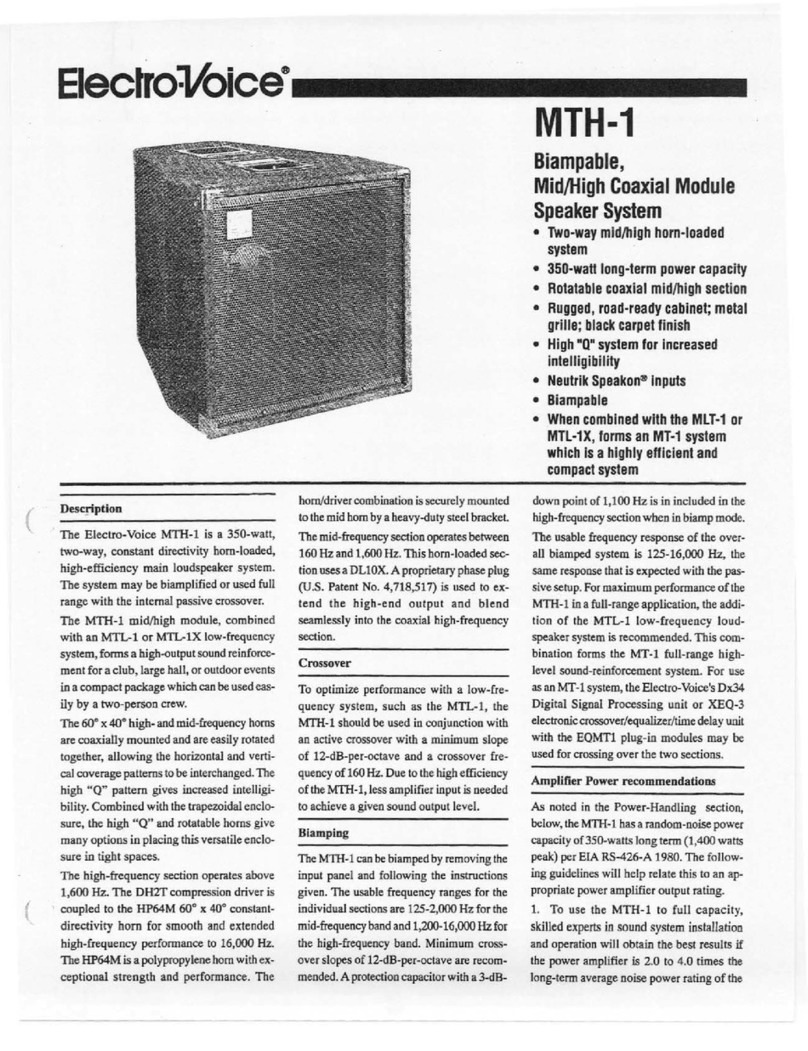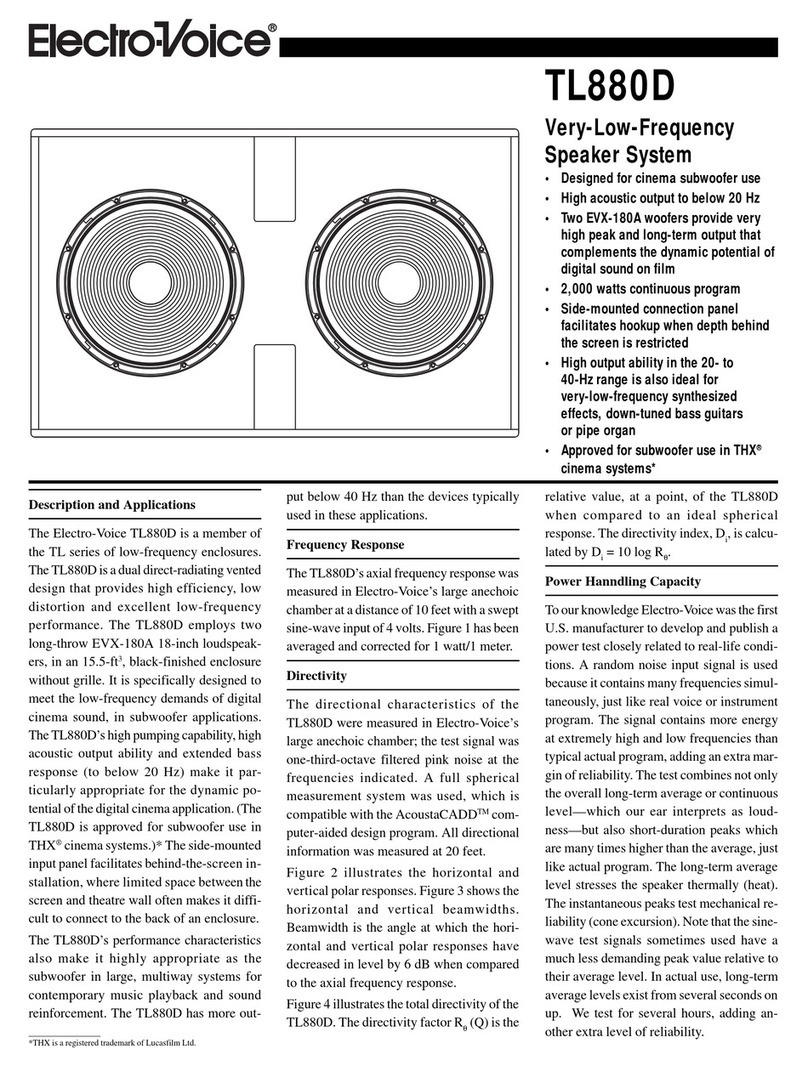
ELECTRO-VOICE a MARK IV company 600 Cecil Street, Buchanan, Michigan 49107
MANUFACTURING PLANTS AT BUCHANAN, MI NEWPORT, TN SEVIERVILLE, TN OKLAHOMA CITY, OK GANANOQUE, ONT.
© Electro-Voice, Inc. 1995 Litho in U.S.A. Part Number 532701 — 9528
1,200-Hzcrossoverfrequencyisrecommended.
Optimum performance and reliability are pro-
vided by 24-dB-per-octave slopes. 12-dB-per-
octaveslopesaretheminimumrecommended.
The low-frequency section should have sub-
passbandprotectionusingahigh-passfilterset
atabout 30 Hz. No signal delay orfurtherEQis
mandatory but their use can smooth response
anddirectivity,particularlyintheregionofcross-
over. The high-frequency section requires the
appropriate constant-directivity-horn high-
frequency boost EQ for flat response.
The Dx34 digital speaker system processor
can be set to provide subpassband protection,
crossover, EQ and signal delay for optimum
performance of the PIM-122. Contact Electro-
Voiceforthespecificparametersettings.Alter-
natively, the XEQ-2 or XEQ-3 analog cross-
over/equalizer/delay networks can be used.
High-frequency horn EQ is provided by plug-in
modules, the specific model of which is deter-
minedbythehornmodel.TheXEQengineering
data sheets provide this specific information.
LOW-FREQUENCY ENHANCEMENT
If it is desirable to enhance low-frequency per-
formance,Electro-Voicerecommends,depend-
ingoninstallationrequirements,thePIM-151or
PIM-251 PI Matrix SeriesTM systems as well as
any of the TL series or MTL series of Manifold
Technology®systems. Contact Electro-Voice
for information on these systems.
FREQUENCY RESPONSE
PIM-122axialfrequencyresponses were mea-
sured in Electro-Voice’s large anechoic cham-
ber at a distance of 3.0 meters (10 feet) with
swept sine-wave input. Figure 2 shows the
typical overall system response with presets of
the Dx34 digital speaker system processor.
Speakerdrivevoltageis4voltsat1kHz.Figure
3 shows the responses of the individual low-
andhigh-frequencysectionswitha4-voltdrive,
normalized for a 1-watt input and a 1-meter
distance.
DIRECTIVITY
The directional characteristics of the PIM-122
were measured in Electro-Voice’s large
anechoic chamber, with a test signal of one-
third-octave filtered pink noise at the frequen-
cies indicated. A full spherical measurement
system, which is fully compatible with Mark IV
Audio’s AcoustaCADD™ computer aided de-
sign program, was used. All directional infor-
mation was measured at 6.1 meters (20 feet).
Figure 8 illustrates the nominal horizontal and
vertical polar responses, with the long system
axis vertical. If the high-frequency horn is ro-
tated, then the horizontal and vertical polars
should be interchanged.
Figure 4 illustrates the horizontal and vertical
beamwidths. Beamwidth is the angle at which
the horizontal and vertical polar responses
have decreased in level by 6-dB when com-
pared to the on-axis frequency response.
Figure 5 represents the total directivity of the
PIM-122. The directivity factor Rθ(Q) is the
relative value, at a point, when compared to an
ideal spherical response. The directivity index
(Di) is calculated by Di = 10log10R.
SERVICE
In the unlikely event the PIM-122 requires ser-
vice, each driver can be replaced or serviced
from the front. A service data sheet is available
from Electro-Voice.
POWER-HANDLING TEST
Electro-Voice components and systems are
manufactured to exacting standards, ensuring
they will hold up, not only through the most
rigorousofpowertests,butalsothroughcontin-
ued use in arduous, real-life conditions. Two
main test specifications are used: the AES
Recommended Practice for Specification of
LoudspeakerComponentsUsedinProfessional
Audioand SoundReinforcement(AES2-1984/
ANSI S4.26-1984) and the EIA Loudspeaker
PowerRatingFull Range(ANSI/EIARS426-A
1980). Both of these specifications use ran-
dom-noisespectrumwhichmimictypicalmusic
and test the thermal and mechanical capabili-
ties of the components. Electro-Voice will sup-
portrelevantadditionalstandardsasand when
they become available. Extreme, in-house
powertests,whichpushtheperformancebound-
aries of the components, are also performed
and passed to ensure years of trouble free
service.
Specifically, the PIM-122 high-frequency sec-
tionpassesAES2-1984/ANSIS4.26-1984with
the following values:
Zmin = 5.6 ohms at 7,000 Hz
PE(max) = 60 watts
Test voltage = 18.3 volts rms
36.7 volts peak (+6 dB)
Selected decade = 1,500-15,000 Hz
The PIM-122 low-frequency passes ANSI/EIA
RS-426-A 1980 with the following values:
RSR = 6.9 ohms (1.15 x RE)
PE(max) = 300 Watts
Test voltage = 45.5 volts rms
91.0 volts peak (+6 dB)
ARCHITECTS’ AND ENGINEERS’
SPECIFICATIONS
Theloudspeakershallbe atwo-waysystemfor
biamplification.Lowfrequenciesshallberepro-
duced by an 8-ohm 305-mm (12-in.) woofer
withanedge-woundflat-wire 63.5-mm (2.5-in.)
voice coil capable of handling 300 watts long
term per ANSI/EIA RS-426-A and with a sensi-
tivity of 95 dB 1 watt/1 meter. High frequencies
shall be reproduced by an 8-ohm compression
driver with a 76.2-mm (3-in.) diaphragm and a
51-mm(2-in.)exit,capableofhandling60watts
long term per AES2-1984/ANSI S4.26-1984,
coupledtoaconstant-directivityhornwitha90°
x 40° coverage pattern and with a sensitivity of
112dB.Thehigh-frequencyhornshallberotat-
able90°aboutitsaxiswithintheenclosure.The
system shall reproduce frequencies from 50 to
18,000 Hz and have a nominal coverage pat-
tern of 90° x 40°, with directivity control main-
tained down to 1,500 Hz. The recommended
crossover frequency shall be 1,200 Hz. Maxi-
mumaveragesoundpressurelevelsat 1meter
shall be 120 dB (low-frequency section) and
129 dB (high-frequency section), with short-
term peaks 6 dB higher.
The enclosure shall be constructed of 7-ply
void-free birch and finished in black textured
paint. The enclosure shall have a trapezoidal
footprint. Dimensions shall be 759 mm (29.9
in.)high,485mm(19.1in.)wideatthefront,267
mm(10.5in.)wideattherearand438mm(17.3
in.)deep.Enclosuresidesshallhavea15°draft
angle. The enclosure shall have a suspension
system approved by an independent structural
engineer and consisting of three independent
suspension points on the top and three on the
bottom, all of which shall mate with Ancra
42546-10 fittings. Net weight shall be 35.4 kg
(78 lb).
The loudspeaker system shall be the Electro-
Voice PIM-122.
Note: the PIM-122 described above is the
standard configuration. Acoustic and me-
chanical details will vary when different op-
tions are supplied.
UNIFORM LIMITED WARRANTY
Electro-Voice products are guaranteed against
malfunction due to defects in materials or work-
manship for a specified period, as noted in the
individual product-line statement(s) below, or in
theindividualproductdatasheetorowner’smanual,
beginning with the date of original purchase. If
such malfunction occurs during the specified pe-
riod,theproductwillberepairedorreplaced(atour
option) without charge. The product will be re-
turned to the customer prepaid. Exclusions and
Limitations:TheLimitedWarrantydoesnotapply
to: (a) exterior finish or appearance; (b) certain
specific items described in the individual product-
line statement(s) below, or in the individual prod-
uctdatasheetorowner’smanual;(c)malfunction
resultingfromuseoroperationoftheproductother
than as specified in the product data sheet or
owner’s manual; (d) malfunction resulting from
misuseor abuseoftheproduct;or (e)malfunction
occurringatanytimeafterrepairshavebeenmade
totheproductbyanyoneotherthanElectro-Voice
or any of its authorized service representatives.
ObtainingWarrantyService:Toobtainwarranty
service, a customer must deliver the product,
prepaid, to Electro-Voice or any of its authorized
servicerepresentativestogetherwithproofofpur-
chase of the product in the form of a bill of sale or
receipted invoice. A list of authorized service rep-
resentativesisavailablefromElectro-Voiceat600
CecilStreet,Buchanan, MI49107(616/695-6831
or 800/234-6831). Incidental and Consequen-
tial Damages Excluded: Product repair or re-
placementandreturntothecustomerare theonly
remediesprovidedtothecustomer.Electro-Voice
shallnotbeliableforanyincidentalorconsequen-
tialdamagesincluding, withoutlimitation,injury to
personsorpropertyorlossofuse.Somestatesdo
notallowtheexclusionorlimitationofincidentalor
consequentialdamagessotheabovelimitationor
exclusion may not apply to you. Other Rights:
This warranty gives you specific legal rights, and
you may also have other rights which vary from
state to state.
Electro-VoiceSpeakersandSpeakerSystems
areguaranteedagainstmalfunctionduetodefects
inmaterialsorworkmanshipforaperiodoffive(5)
years from the date of original purchase. The
Limited Warranty does not apply to burned voice
coils or malfunctions such as cone and/or coil
damage resulting from improperly designed en-
closures. Electro-Voice active electronics associ-
atedwith thespeakersystemsareguaranteed for
three(3)yearsfrom the date oforiginalpurchase.
Additional details are included in the Uniform
Limited Warranty statement.
Electro-VoiceFlyingHardware(includingenclo-
sure-mountedhardware andrigging accessories)
is guaranteed against malfunction due to defects
inmaterialsorworkmanshipforaperiodofone(1)
yearfromthedateoforiginalpurchase.Additional
details are included in the Uniform Limited War-
ranty statement.
Electro-Voice Accessories are guaranteed
against malfunction due to defects in materials or
workmanshipforaperiodofone(1)yearfromthe
date of original purchase. Additional details are
included in the Uniform Limited Warranty state-
ment.
Serviceandrepairaddressforthisproduct:Electro-
Voice,Inc.,600CecilStreet,Buchanan,Michigan
49107 (616/695-6831 or 800/234-6831).
Specifications subject to change without notice.
